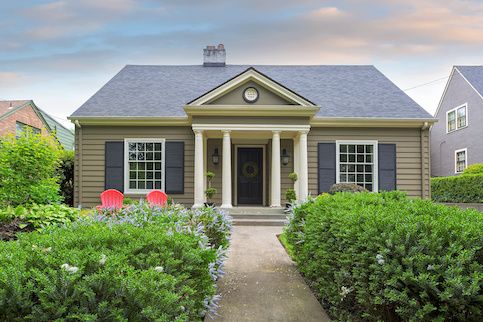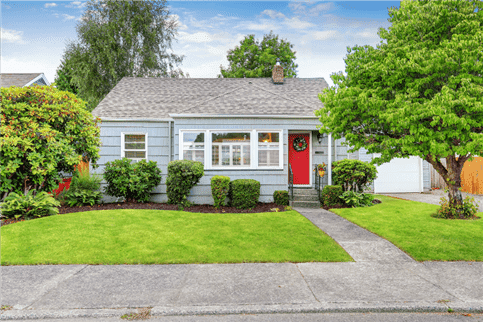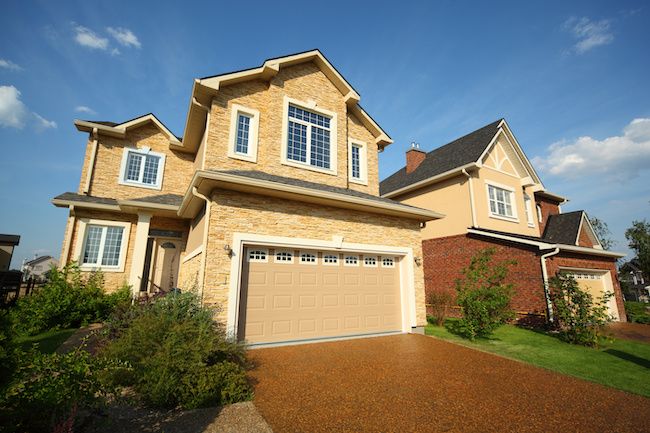If you want to buy a home, the odds are that you can’t afford to pay cash upfront. The majority of people turn to a home loan, also called a mortgage, when they want to buy a property. Though mortgages are all used for the same purpose – to buy a home – there are many different types out there. Choosing the right home loan for your situation is important.
Key Takeaways:
- Typical mortgage terms are 15 years and 30 years, with shorter terms offering lower interest rates but higher monthly payments.
- Fixed-rate mortgages offer stability, while adjustable-rate mortgages have lower starting rates that could rise over time.
- Many government-backed loan programs offer easier qualifying requirements, including lower down payments.
Mortgage Loan Basics
Though there are many different home loan types, they all share a few characteristics. These are the basic concepts that apply to almost any type of mortgage.
What’s Your Goal?
Buy A Home
Discover mortgage options that fit your unique financial needs.

Refinance
Refinance your mortgage to have more money for what matters.
Tap Into Equity
Use your home’s equity and unlock cash to achieve your goals.
Fixed-Rate Vs. Adjustable-Rate Mortgages
When you get any type of loan, including a home loan, you typically have to pay interest on the money that you borrow. The interest rate on your home loan can be fixed or adjustable.
With fixed-rate mortgages, you pay a set interest rate. You’ll know the rate when you sign the mortgage paperwork, and that rate will never change throughout the entire loan term. Adjustable-rate mortgages have interest rates that change based on an index, rising or falling over time.
Usually, you’ll see ARMs quoted using two numbers, such as 3/1 or 5/1. The first number represents an initial fixed-rate period. During that time, which can range from several months to a few years, the rate on the ARM won’t change. The second number represents the adjustment period, or how often the rate will change after the initial fixed-rate period. For example, a 5/1 ARM has an introductory rate that won’t change for the first five years. After that, the rate will adjust every year.
Typically, ARMs have lower starting interest rates than fixed-rate mortgages. That means ARMs can offer a lower monthly payment – at least at first. If the ARM’s rate adjusts upward after the introductory period, your monthly payment will also rise.
Fixed-rate loans tend to have slightly higher interest rates but offer the benefit of stability. You don’t have to worry about rising rates making your loan unaffordable down the line.
Comparing Fixed-Rate Mortgages And ARMs
| Fixed-Rate Mortgage | Adjustable-Rate Mortgage |
|---|---|
| Higher initial rate. | Usually lower initial rate. |
| Interest rate never changes. | Rate changes on a regular basis after a fixed introductory period. |
| Your monthly payment is more stable. | Payments can rise if interest rates rise. |
30-Year Vs. 15-Year Loan Terms
The other feature that all home loan types share is a set term. This is the period over which you’ll pay the loan off, assuming you follow the payment schedule.
Traditionally, mortgages have either a 30-year term or a 15-year term. Usually, 15-year loans have lower interest rates. You end up paying less over the life of the loan, but the monthly payments are higher due to the shorter term. On the other hand, 30-year loans have lower monthly payments but cost more in the long run. A 30-year fixed-rate loan is the most common type of mortgage.
It’s also possible to find lenders offering custom terms. For example, you might find a 20-year or 10-year mortgage option.
Comparing 30-Year And 15-Year Loan Terms
| 30-Year Mortgage | 15-Year Mortgage |
|---|---|
| Lower monthly payment. | Higher monthly payment. |
| Higher interest rate. | Lower interest rate. |
| Costs more overall. | Costs less overall. |
| More purchasing power. | Builds equity more quickly. |
Conventional Loans
Home loans can be broken down into two broad categories: conventional loans and government-backed loans.
“Most people will end up with a conventional loan,” says Jay Zigmont, Certified Financial Planner and Founder of Childfree Wealth, a life and financial planning firm based in Mount Juliet, Tennessee. “When people think of a 30-year mortgage, they are probably thinking of a conventional loan.”
Conventional loans are not part of any government program and come in two forms.
Conforming Loans
Conforming loans are mortgages that satisfy criteria set by the Federal Housing Finance Agency and Fannie Mae and Freddie Mac, which are government-sponsored enterprises. These criteria relate to loan amounts, down payment requirements, credit score requirements and more.
In 2024, conforming loans for one-unit properties can be for no more than $766,550 in most of the country, though they can be as large as $1,149,825 in certain high-cost areas.
Typically, if you offer a down payment of less than 20% of the home’s purchase price, you’ll have to pay for private mortgage insurance. If you can’t afford a 20% down payment, down payments as low as 3% are available if you meet requirements. In that case, you’d have to pay PMI until you build 20% equity in your home.
Conforming Loans Pros And Cons
| Pros | Cons |
|---|---|
| Most common type of loan. | Lending guidelines can be strict. |
| Low down payment requirements. | May require a higher credit score than a government loan. |
| Can get rid of mortgage insurance. | Mortgage insurance required with a down payment of less than 20%. |
Non-Conforming Or Jumbo Loans
Non-conforming loans are any loans that aren’t backed by a government program and don’t comply with the rules set by Fannie Mae, Freddie Mac and the FHFA.
Jumbo loans are among the most common types of non-conforming loans. Their name refers to the fact that they are loans for amounts that exceed the conforming loan limits.
Jumbo Loans Pros And Cons
| Pros | Cons |
|---|---|
| Can exceed conforming loan limits. | May have higher credit score requirements than conforming loans. |
| Unique loan features may be useful for some borrowers. | Large down payment requirement. |
| You can buy a more expensive home. | Larger loans mean larger monthly payments. |
Other types of non-conforming loans can have nontraditional features, such as allowing interest-only payments or balloon payments. They can also be targeted at consumers with specific needs, such as those with poor credit or those with large incomes but also significant debt, like newly graduated doctors.
Ready To Become A Homeowner?
Get matched with a lender that can help you find the right mortgage.
Government-Backed Loans
Certain home loans are part of specialized programs backed by the government. Some government-insured loans are available to most borrowers, while others are aimed at specific groups of people or only intended for specific types of properties.
FHA Loans
If you have less-than-perfect credit, FHA loans could help you qualify for a mortgage. You can get a loan backed by the Federal Housing Administration even if your credit score is as low as 500. However, you’d need to make a 10% down payment, and not all lenders offer this option. A credit score of at least 580 allows for a down payment as small as 3.5%.
One drawback of FHA loans is mandatory mortgage insurance. FHA loans require both an upfront mortgage insurance premium and an annual MIP, which usually lasts the life of the loan. The exception is, if you make a minimum 10% down payment, you can get rid of your annual mortgage insurance after 11 years.
“Comparing FHA loans to conventional loans isn’t just about interest rates,” says R.J. Weiss, Certified Financial Planner and Founder of personal finance website The Ways To Wealth, based in Geneva, Illinois. “FHA loans tend to have more associated costs, including mandatory (mortgage insurance) and potentially higher upfront fees.”
FHA Loans Pros And Cons
| Pros | Cons |
|---|---|
| Flexible credit requirements. | Strict appraisal requirements. |
| Allow down payments as low as 3.5%. | Loan limits restrict how much home you can buy. |
| Competitive interest rates. | Annual mortgage insurance payments that are hard to eliminate. |
VA Loans
VA loans are available to home buyers who are eligible active-duty military service members, reservists, veterans or surviving spouses of those who died while on active duty or as a result of a service-connected disability.
What makes VA loans particularly appealing is that they don’t require a down payment. The Department of Veterans Affairs also doesn’t set specific VA guidelines for credit scores – though lenders may have their own requirements.
VA Loans Pros And Cons
| Pros | Cons |
|---|---|
| No down payment required. | Must pay the VA funding fee, which is between 1.25% and 3.3% of your loan amount. |
| Interest rates tend to be lower. | Can only finance a primary residence. |
| No mortgage insurance. | Appraiser must be approved by the VA. |
USDA Loans
USDA loans are specialized mortgages that can be used to buy property in qualifying rural areas. They’re targeted at low-income borrowers who may not otherwise have access to a decent place to live. Accordingly, there are strict limitations on how much you can make to qualify.
If you meet the income limits and other requirements, you can purchase a single-family property without any down payment.
USDA Loans Pros And Cons
| Pros | Cons |
|---|---|
| No down payment required. | Can only be used to buy homes in designated areas. |
| Provide safe and sanitary housing for borrowers who otherwise might not be able to afford it. | Strict income limits. |
| Lower fees than FHA loans. | Guarantee fees. |
Choosing A Home Loan Type
Deciding on a home loan can be difficult, but it’s important to do your research.
“The key with any mortgage is to make sure it fits your needs and budget,” Zigmont says.
The right mortgage can help you buy a home sooner and help you save a lot of money. Here are some questions to consider when making your decision.
Take The First Step To Buying A Home
Find a lender that will work with your unique financial situation.
What’s Your Credit Score?
One of the most important factors to consider when choosing a home loan type is your credit. If you have strong credit, you’ll have an easier time qualifying for a loan and getting a lower interest rate. If you have poorer credit, a government-backed loan like an FHA loan may be the cheapest option and easier to qualify for.
Keep in mind that the lowest credit score you can have to qualify for an FHA loan is 500. Conforming conventional loans require a credit score of at least 620.
What’s Your DTI Ratio?
Like your credit score, your debt-to-income ratio also plays a big role in your ability to get a loan. Some loan programs or lenders have strict DTI ratio requirements.
Conforming conventional loans that are manually underwritten have a maximum DTI ratio of 36% by default, though you can go up to 45% if you have strong credit and savings.
How Much Down Payment Can You Afford?
Having more money for a down payment does more than show lenders your ability to afford a home. A larger down payment means borrowing less money, which leads to a lower monthly payment. If you can afford a 20% down payment on a conventional loan, you also won’t have to pay for PMI – saving you even more money.
What’s The Monthly Mortgage Payment?
Above all else, it’s important to make sure that any mortgage you agree to has an affordable monthly payment. You don’t want to find yourself in a situation where you can’t cover your monthly bills.
Zigmont recommends keeping your mortgage payment under one-third of your take-home income to avoid the risk of becoming “house poor” – even if banks approve you for a bigger home loan.
One way to lower your monthly payment is choosing a longer loan term. You would save a lot of money on interest with a 15-year term compared with a 30-year term, but the monthly payment is also higher with a shorter term. If a larger payment would strain your budget, you’ll want to stick with the longer term.
What Other Fees Do I Need To Pay?
Mortgages come with a lot of fees, and those costs are affected by the type of loan you choose.
“While the optimal strategy is to save 20% for a down payment on a conventional loan and have a high credit score to avoid these extra costs, that’s a lot easier said than done,” Weiss says.
It’s important to consider all the potential costs before settling on a home and a loan type:
- Mortgage insurance: Many loan types will require some form of mortgage insurance, which is an extra cost. See if you can qualify for a loan that doesn’t require it.
- Property taxes: Property taxes pay for a variety of local amenities. The bill can vary widely depending on where you live and how much your home is worth.
- Homeowners insurance: Almost every lender will require that you carry homeowners insurance. The cost of coverage will depend on your home’s risk factors, such as its location, local weather and other factors.
- Homeowners association fees: If you buy a home in an HOA community, you’ll have to pay a fee for the services and amenities.
- Maintenance and repairs: Homes require upkeep. A popular rule of thumb is to earmark 1% to 4% of your home’s value annually as a fund for maintenance and repairs.
The Bottom Line
When shopping for a home, take the time to evaluate the different types of mortgages that are available to you, and select the one that best fits your needs. FHA loans, with their easier qualifying requirements, can be a good fit for people who are looking to get on the property ladder sooner rather than later. Conventional loans are usually less expensive than FHA loans, so they’re a good fit for those who can qualify. With enough research, you should be able to find the best loan option for your financial situation.
More From Quicken Loans:
Kara Porter contributed to the reporting of this article.

T.J. Porter
T.J. Porter is a Boston-based writer who focuses on credit cards, credit and bank accounts. When he's not writing about all things personal finance, he enjoys cooking, esports, soccer, hockey, and games of the video and board varieties.












